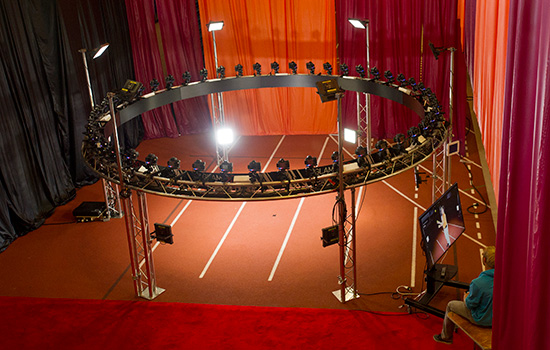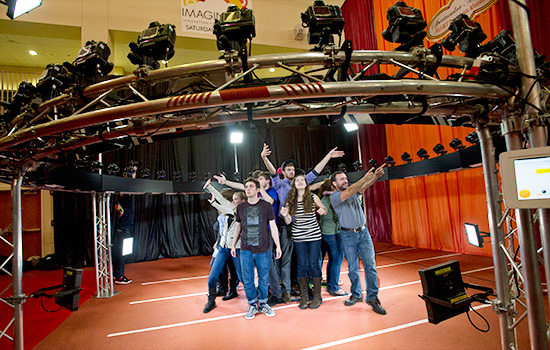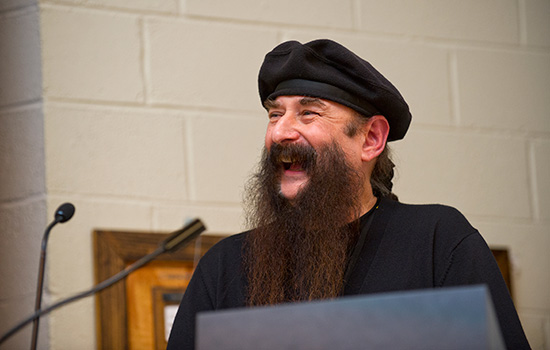Alumnus captures big success with Big Freeze
Robert Latorre
A large advertising agency in Dallas approached Robert Latorre in the early 1990s with an idea. Agents were developing an ad campaign for M.D. Anderson Cancer Center and they wanted to illustrate visually how cancer stops a life. The idea was to freeze time and look at patients in a complete circle for 12 seconds.
“I said to myself, ‘How are we going to achieve this?’” Latorre ’75 (photography) remembered.
Latorre, who had built a reputation as a still photographer and then a commercial TV-spot director, liked a challenge. He began engineering a camera system, and 11 months later, he and his team had developed the first version of The Big Freeze. The four commercials made for M.D. Anderson won several national awards, including a Clio for visual effects.
The Big Freeze, a large metal truss system with up to 360 cameras that captures a frozen scene in an instant, is now in its sixth generation. It has been used at The Golden Globes, the Grammys and the Emmys (known as the GlamCam 360); in the filming of hundreds of television commercials; and at live concerts, music festivals and sporting events all over the world.
“We have taken The Big Freeze effects, that would take weeks to create in post-production for just one effect, to an eye-popping visual effect that now takes seconds to share,” he said, adding that he created the tools to make that happen by tapping into his interest in science and engineering.
Latorre came to RIT in the early 1970s after getting a Bachelor of Arts degree from New York University because he wanted to study photography at a school with the latest technology. “I knew from that point forward that all I wanted to do was to make images, and the best place to do this was at RIT.”
After graduation, he moved back to New York City and became a photojournalist shooting for news wire services. He had some early success and before he knew it, he had landed photos on the cover of Newsweek.
Having grown up in the New York City area, Latorre decided it was time to live in a different part of the country, so he packed up his car and headed to Los Angeles. On the way, he stopped at a friend’s house in Dallas, who convinced him to show his portfolio there.
“He gave me a few names to see. I went and saw these folks and I got three photo jobs in one day,” Latorre said. “One job led to the next shoot. I have been in Dallas for 33 years.”
He established his own still photography production company in 1979 after talking a banker into loaning him $30,000 to purchase equipment. (He paid the money back within a year.) By 1990, he turned his attention to TV commercial spot production and created Big Fish Films, which does work all over the world. Latorre has filmed for Samsung, Honda, Heineken, Coke, Xerox and American Airlines, to name a few.
Latorre said clients come to him to shoot unusual assignments, such as a car flying through a wall of water at 70 mph, because they know he likes a challenge.
That’s why he continues to improve The Big Freeze—he’s never satisfied with the current product when he knows technology can be improved.
His latest version creates 360-degree holograms. His team also has just completed its second 360-degree photo booth called a PODCAM360, where visitors can select an LED background (swimming with whales, standing on Mars) and activate the LED photo of them immersed within that background. PODCAM360s are now in science centers in Seattle and Hartford, Conn. He hopes to build more for large private enterprises such as Cirque du Soleil.
“I am the kind of guy who is challenged about making it better. That’s what keeps my interest,” Latorre said. “My obligation to my clients is to keep making it better.”
 The Big Freeze, now in its sixth generation, is a large metal truss system with up to 360 cameras that captures a frozen scene in an instant.
A. Sue Weisler
The Big Freeze, now in its sixth generation, is a large metal truss system with up to 360 cameras that captures a frozen scene in an instant.
A. Sue Weisler
 Robert Latorre ’75 (photography) visited the RIT campus in October to talk about his career and his invention, The Big Freeze. After the talk, photography students and faculty had the opportunity to try The Big Freeze.
A. Sue Weisler
Robert Latorre ’75 (photography) visited the RIT campus in October to talk about his career and his invention, The Big Freeze. After the talk, photography students and faculty had the opportunity to try The Big Freeze.
A. Sue Weisler















